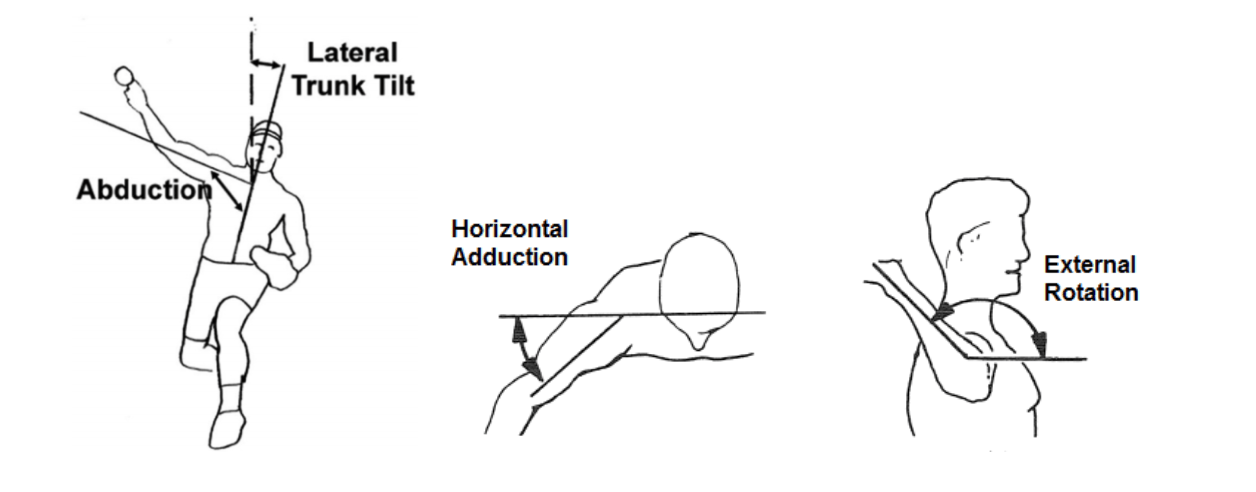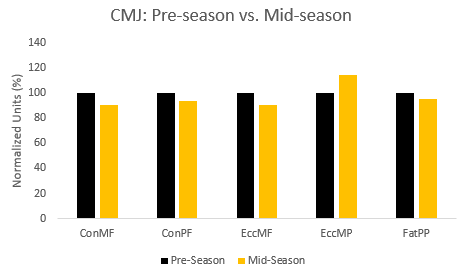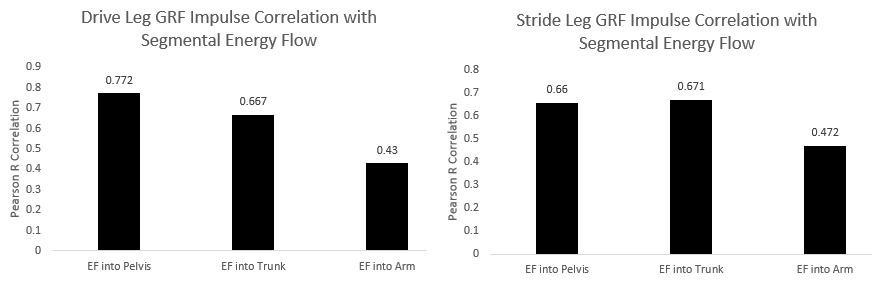Caught Looking: Articles of the Week – July 30

Here are three studies the R&D department at Driveline read this week:
Neuromuscular Fatigue in Pitchers Across a Collegiate Baseball Season
Understanding fatigue can help us better manipulate workload/training economy throughout a season or training program to maximize performance and athlete health. Stone et al. recently studied neuromuscular fatigue in pitchers throughout a DI college baseball season using a counter-movement jump (CMJ).
This study showed reduced CMJ performance from pre-season to mid-season, though the difference was not statistically significant. There were no moderate or large differences in performance between the other times of the season.
Figure made with tabular data from the linked study (Stone 2020)
Decreased CMJ performance over the season could represent general fatigue for an athlete as cumulative workload builds throughout their appearances. Even though CMJ performance can’t necessarily be used as an arm-specific fatigue measurement, it does provide some evidence toward the general neuromuscular fatigue associated with college baseball pitchers’ season. A continued investigation could include a larger sample size and more specific measures of fatigue, such as a change in kinematics, change in release point, velocity, etc.
For more information on neuromuscular fatigue, how we look at it, and some of the factors involved, check out our blog on CNS fatigue.
Peak horizontal ground reaction forces and imPulse correlate with segmental energy flow in youth baseball pitchers
The way pitchers interact with the ground has often been discussed as an important topic for performance and health in baseball pitching.
Many studies have compared peak forces to performance outcomes like pitching velocity or certain biomechanical parameters such as mid-section positioning. Howenstein et al. furthered this work with a comparison of ground reaction forces (how hard pitchers push off with their back leg and brake with their front leg) and the flow of energy between body segments.
This study found that two measures of ground reaction force correlated to energy flow between pelvis, torso, and arm segments in the pitching motion for youth athletes. Energy flow has shown in the past to be a strong predictor of pitched ball velocity, so finding ways to improve this energy flow would very likely improve velocity.
Interestingly, the authors discuss a theory that the drive, push-off leg plays a more important role in transferring energy into the mid-section body segments (pelvis and torso), which provides a foundation for an effective kinetic chain. They also theorize that the front, braking leg plays more of a role in initiating the rotation aspect of the kinetic chain, which transfers better to the arm and velocity of the ball.
Figure made with tabular data from the linked study (Howenstein 2020)
Only youth athletes (average age around 11 years old) were used for this analysis, so we cannot be sure these same relationships exist for higher levels of competition. Nonetheless, furthering this research with older and more experienced amateur or professional athletes would be very valuable contributions to the pitching biomechanics world.
To read about some of our early ground reaction force research, take a look at this blog from 2017!
The relationship between variability in baseball pitching kinematics and consistency in pitch location
Command is a relatively unknown area of pitching biomechanics and the underlying cause of the ability or inability to control where each pitch location has eluded baseball researchers and coaches. Glanzer et al. in 2019 attempted to find this cause by looking at variability in pitching mechanics during assessment sessions at the American Sports Medicine Institute.
In this study, the group was able to create a model that described 58% of the variance in pitch location using only five mechanical measurements: torso tilt, shoulder abduction, shoulder horizontal abduction, maximum external rotation, and maximum horizontal adduction.
This means that with these five measures, the experimenters were confident they could explain more than half of the variance in pitch location consistency, which could be incredibly valuable.
Consistency in pitching mechanics is commonly thought of as the driver for good command, and relating the variability in these mechanics to pitching command is a step forward for testing those theories.
One note is that this study did not describe whether or not the participants were instructed to throw to the exact same spot, so it is possible the dataset could be improved. Regardless, this is a very exciting corner of baseball research, and we hope to continue making progress to understanding what it takes to achieve elite command.
If you are interested in our version of a program to train command, check out our how and why of differential command baseballs!
By Kyle Lindley (@kylelindley_)
Comment section
Add a Comment
You must be logged in to post a comment.


David D. Love -
What is the ideal lateral trunk tilt for an over the top pitcher? Thanks
David Besky -
David – lateral trunk tilt is going to be closely linked to arm slot, which will vary pitcher to pitcher, so there is not a particular lateral trunk tilt we would consider ideal across pitchers. The range of lateral trunk tilt we see from our athletes in gym is from -6 to 30, with the majority of athletes being between 5 and 20. Thus, higher arm slot guys will mostly be in that 10-20 degree range.